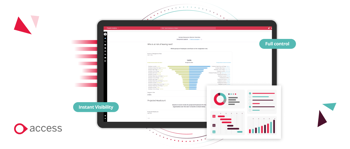
What is talent pipeline management?
Talent pipeline management is a strategic process that aligns recruitment with business planning. By anticipating future hiring needs and building relationships early, organisations can reduce time-to-hire, improve candidate quality, and create a more resilient workforce.
Unlike traditional recruitment, which often begins when a role becomes vacant, pipeline management is continuous. It involves sourcing talent, nurturing relationships, and using data to make informed decisions. For growing businesses, this approach ensures that hiring doesn’t become a bottleneck to progress.
What are the key component of talent pipeline management?
A successful pipeline is built on several interconnected elements:
- Talent sourcing - Identifying individuals who could be a good fit for future roles, whether they’re actively looking or not. This often involves tapping into passive talent pools, attending industry events, and using platforms like LinkedIn to build connections.
- Candidate nurturing - Candidates who aren’t ready to move today might be ideal in six months. Keeping them engaged through thoughtful communication, employer branding, and personalised content helps maintain interest and trust.
- Relationship building - Candidates are more likely to consider a role if they’ve already had positive interactions with your brand.
- Data and analytics - Tracking engagement, analysing conversion rates, and forecasting future needs ensures your pipeline remains healthy and aligned with business goals.
How can you build a talent pipeline from scratch?
Starting from scratch can feel daunting, but the foundations of a strong pipeline are rooted in clarity and consistency. Begin by understanding where your business is heading. What roles are likely to emerge in the next 6 to 12 months? Which departments are expanding, and what skills will be in demand?
The next step is to define candidate personas, which are fictional profiles based on real hiring data, that can help your sourcing strategy. Personas can capture motivations, preferred working styles and career aspirations. Dedicating time to creating candidate personas can make it easier to tailor your messaging.
Sourcing should be both broad and targeted. While job boards and LinkedIn remain essential, don’t overlook passive candidates. Our guide on ‘How to attract and recruit passive candidates’ can help you discover strategies to maintain engagement with these candidates and feed them into roles. Recruitment marketing plays a key role here. A strong employer brand, supported by authentic content and employee stories, can spark interest long before a vacancy is posted.
How to build a diverse talent pipeline
Diversity in hiring is a significant commitment and can vary across industries. Building teams with a range of perspectives, backgrounds, and experiences can strengthen your organisation. For example, financial institutions still struggle with creating diverse teams, but we have addressed how organisations can build more diverse and inclusive teams with actionable strategies in our blog on ‘Diversity & Inclusion in Financial Services’. A diverse pipeline doesn’t happen by accident; it requires intentional sourcing and inclusive practices at every stage.
Start by expanding where and how you search for candidates. Partnering with community organisations, attending events focused on underrepresented groups, and using DEI-focused job boards can help widen your reach. A survey of 2,000 women and 500 men within the UK workforce, found that more than two in three respondents (69%) believe that gender bias is a barrier to leadership. Internally, employee resource groups (ERGs) and referral programmes can also be powerful tools for surfacing diverse talent.
Screening and interviewing processes should be reviewed regularly to minimise bias. Structured interviews, blind CV reviews, and diverse interview panels all contribute to fairer outcomes. Inclusion is ultimately about creating an environment where candidates feel seen and valued. Reviewing the whole hiring process can also be beneficial; learn more about ‘The 7 steps for hiring the best talent’ in our blog.
Tools and Platforms to Support Pipeline Building
Managing a talent pipeline manually is possible but rarely sustainable. As your business grows, so does the complexity of recruitment. Applicant Tracking Systems (ATS) help streamline the process by automating workflows, tracking candidate progress, and centralising communication. Recruitment CRMs go a step further, allowing you to build long-term relationships with passive candidates and segment talent pools based on future needs.
Access Recruitment Software provides a centralised solution for managing the entire hiring journey, while Access Applicant Tracking automates key tasks like vacancy creation, interview scheduling, and candidate communications. Together, they offer a streamlined, branded experience that helps recruiters stay organised, responsive, and aligned with business goals.
How can you grow and maintain a strong talent pipeline?
Once your pipeline is in place, the challenge shifts to keeping it active and relevant. Candidates who were a great fit six months ago may have moved on, while new talent enters the market every day. That’s why consistent engagement is key. A well-maintained pipeline feels less like a database and more like a community of future colleagues.
Candidate experience plays a central role here. Every interaction, whether it’s an email, interview, or feedback request, contributes to how your brand is perceived. Candidates who feel respected and informed are more likely to stay engaged, even if they’re not hired immediately. A candidate experience survey can help you gauge your process and action feedback, and you can learn how to create one with our blog on ‘How to Create a Candidate Experience Survey: Best Practices & Free Template’.
FullCircl used Access Engage to create a branded benefits platform that resonated with employees and candidates alike. By focusing on consistent communication and a strong value proposition, they were able to nurture talent more effectively and improve long-term engagement.
What are the benefits of a strong talent pipeline?
Organisations with mature pipelines consistently report faster hiring times, better candidate quality, and lower recruitment costs. According to Gartner, organisations with agile high-potential employee strategies are 70% more likely to have a strong leadership bench, directly contributing to faster succession planning and reduced hiring delays.
McKinsey research further shows that top performers in critical roles deliver 800% more productivity than average performers, underscoring the value of proactively identifying and nurturing talent through strategic pipelines.
When roles are filled quickly, teams stay productive. When candidates are pre-qualified and culturally aligned, retention improves. And when recruitment is proactive rather than reactive, HR teams can focus on strategic initiatives rather than firefighting.
There’s also a competitive edge. In sectors where talent is scarce, having a ready pool of engaged candidates can make the difference between winning and losing top performers.
Metrics to Track Pipeline Health
To understand whether your pipeline is working, you need to measure it. Time-to-hire is a useful starting point, but it doesn’t tell the whole story. A 2023 Robert Half survey showed that 83% of hiring managers missed a good hire during the past year and 29% of them attribute that loss to a long time to hire.
Quality of hire is equally important. Conversion rates between pipeline stages can reveal bottlenecks. Are candidates dropping off after initial contact? Is the interview process too slow? These insights help refine your approach and improve outcomes.
Access PeopleXD Evo and Access Applicant Tracking can both demonstrate these metrics in reporting dashboards. With real-time data, HR teams can make informed decisions and adjust strategies before issues escalate.

Expert Insight
Emma Parkin, Head of Propositions at The Access Group, details the time to hire and how longer timeframes can impact recruitment. Emma also highlights some of the other recruitment challenges currently facing HR teams.
How can you leverage your internal talent pipeline?
Internal talent pipelines allow businesses to respond quickly to change, reduce external hiring costs, and retain valuable institutional knowledge. The first step is recognising high-potential employees, with the ambition, adaptability, and capacity to take on more. Upskilling and reskilling programmes can then help prepare employees for leadership roles or pivot to new functions. Succession planning ties it all together. By mapping out future leadership needs and aligning them with internal development, organisations can avoid disruption and build continuity into their workforce strategy.
LinkedIn’s Global Talent Trends show that internal mobility across companies rose 6% year-over-year, which improves engagement, agility, retention, and reduces cost/time in recruiting.
Tools for Internal Mobility
Technology makes internal mobility more visible and manageable. Learning and development platforms help track progress and personalise growth plans. Internal job boards ensure employees are aware of opportunities across the business, while career pathing frameworks give clarity on how to move forward.
Our HR software supports all of these elements, offering tools to manage job boards, development plans, and succession pathways in one place. It helps HR teams create a structured, transparent approach to internal mobility that employees can trust and engage with.
How to plan your future talent pipeline with technology
A forward-looking talent strategy is one that anticipates business needs rather than just reacting. As industries shift and new roles emerge, HR leaders can benefit from being able to forecast future skills and align recruitment accordingly.
This begins with understanding where the business is heading. Strategic workforce planning tools can help model growth scenarios, identify emerging skill gaps, and ensure recruitment is aligned with long-term goals.
Future-Proofing Your Workforce
Technology plays a central role in futureproofing. AI and automation are transforming recruitment, making it faster, more targeted, and less prone to bias. Talent intelligence platforms offer insights into market trends, competitor activity, and candidate behaviour, which gives HR teams the data they need to stay ahead.
Scenario planning adds another layer of resilience. By preparing for multiple outcomes, organisations can adapt quickly and maintain momentum even when conditions change.
“We’re using industrial-age tools to solve digital-age problems. And every day we persist with these broken systems, the skills gap widens, engagement drops, and our best people leave for organisations that get it.”
Emma Parkin, Head of Propositions at The Access Group in Beyond Annual Reviews
How to build a talent pipeline that scales with you
A strong talent pipeline is the result of consistent effort, strategic planning, and a genuine commitment to engaging people before they become candidates. For growing businesses, this approach transforms recruitment from a reactive process into a proactive advantage.
By investing in early engagement, inclusive sourcing, internal mobility, and future-focused planning, organisations can create a pipeline that not only fills roles but supports long-term growth. Technology plays a vital role in making this scalable. It can streamline workflows, surface insights, and help HR teams stay connected to the talent that will shape their future.
Ready to streamline your hiring process and build a future-ready talent pipeline? Discover Access Recruitment Software and see how it can support your growth.
Looking to develop internal talent and improve workforce planning? Learn more about Access PeopleXD Evo and its powerful HR capabilities.

 AU & NZ
AU & NZ
 SG
SG
 MY
MY
 US
US
 IE
IE

